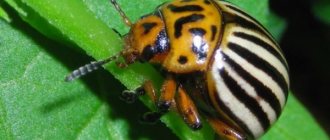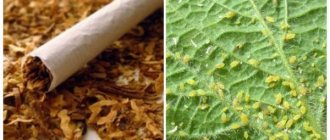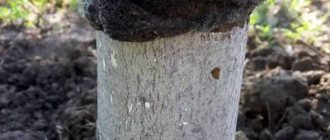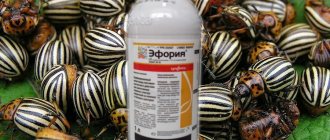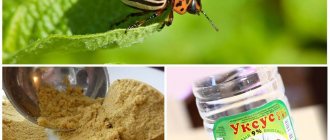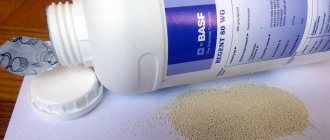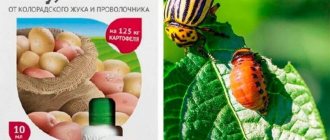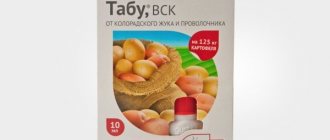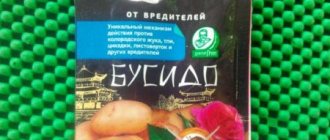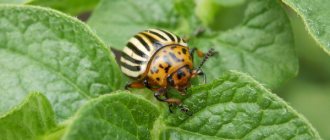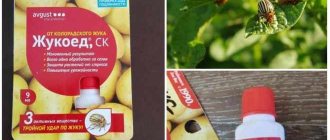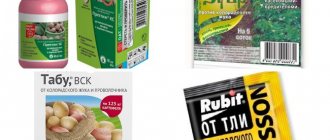The insecticide Corado is produced in the Russian Federation in Nizhny Novgorod by LLC “Vashe Khozyaystvo”. The active substance (AI) of this drug - imidacloprid from the chemical class of neonicotinoids - in the same concentration of 20% (200 g/1 l) is used in several dozen pesticides for similar purposes (Tanrek, Imidor, Prestige, etc.). Their formulations are also the same: ready-to-use solution (VR or P). However, it would be wrong to consider Corado only a fruit and a means of competition: this drug is intended for use in private household plots not only in terms of volume and type of packaging, but also in terms of its full chemical composition, see below. For a presentation of Corado (of an advertising nature), see the video below:
What is the difference?
The full composition of pesticides for spraying treatment includes, in addition to the active ingredients, adhesives (surfactants, surfactants), ballast additives, which to some extent regulate the translaminar and biological activity of the drug (its ability to penetrate plant tissues and effectiveness on objects to be eliminated), and a solvent . The solvent also plays a certain role in the properties and activity of the drug.
While manufacturers willingly disclose the composition and concentration of additives to everyone, branded surfactants, ballast and solvent are a taboo and a sealed secret, known only to the leading specialists of the developer company, especially since there is practically no information on the dangers and toxicological properties of the finished drug surfactant and ballast. influence. But they largely determine the scope of application of the product and the features of its use. Corado's solvent is certainly different from that of other pesticides with neonicotinoids: a pungent odor of some organic volatile liquid spreads from the opened package of the drug.
In terms of general indicators, Corado is the same as its analogues (not complete) at 20% imidacloprid:
- It has high translaminar activity - it is completely absorbed into the plant tissue in 2-3 hours;
- The protective effect is high - correct application (see below) ensures 100% destruction of a pest population of any volume and density at any phase of its development;
- The drug is not phytotoxic;
- Effective against pests resistant to pesticides based on other chemicals;
- Resistance of elimination objects to imidacloprid itself has not been recorded;
- The effectiveness of the drug is practically independent of the weather (imidacloprid is neither photolytic nor hydrolytic);
- Temperature range of effectiveness of the drug is +(12-25) degrees Celsius;
- The degree of danger of imidacloprid for humans and warm-blooded animals is 3 (moderately dangerous substance), but chronic poisoning with microdoses of DV produces long-term negative after-effects, incl. mutagenic and teratogenic (on fetal development in pregnant women);
- In the external environment, imidacloprid persists for a long time (half-life in soil up to 8 months);
- The degree of danger of the drug for bees and aquatic organisms is 1st (extremely dangerous substance).
Note: the craze for such seemingly convenient neonicotinoids has led in a number of countries around the world (the list of which is ever expanding) to the extinction of domestic bees and beneficial wild insects - pollinators and entomophages. This threatens an environmental disaster on a planetary scale. Currently in the EU and some. In other countries, the use of pesticides with neonicotinoids on open ground crops is prohibited.
At the same time, the effect of the drug Corado is noticeably different from agrochemicals for a similar purpose:
- The speed of action is below average - the pests stop feeding within 2-3 hours and die within 2-3 days (apparently, the manufacturer has developed a surfactant that regulates the translaminar activity of the drug);
- For the same alleged reason, the protective effect of Corado is longer, up to 20 days;
- As a consequence of paragraphs. 1 and 2, the effect of the drug on the imago (adult individuals) of the Colorado potato beetle is weakened - the beetles have time to migrate before dying;
- Some ovicidal activity of the drug was noted: a decrease in the volume of oviposition of pests, anomalies in the development of eggs and a decrease in the percentage of larvae hatching from them;
- The dosage and consumption rates of the drug are even less than those of others at 20% imidacloprid. This reduces the cost of one treatment, but in no case gives a reason to neglect precautions, see below;
- Corado in tank mixtures is incompatible with other agrochemicals. However, in private household plots treatment with mixtures is almost never carried out;
- In certain dosages (see below), Corado exhibits fungicidal activity.
Note: the acaricidal activity of neonicotinoids is a myth, most likely generated by “network hamsters” and “sofa barmalogs”. Harmful mites have a significantly different metabolism than insects. After the use of neonicotinoids, a decrease in the number of predatory mites, pest exterminators, was noted on plants. But in laboratory conditions, the LD50 doses for them turn out to be several times and orders of magnitude higher than for insects. But in natural conditions - well, where do the predators have to go, since, excuse me, all the food has died?
Advantages of the drug
The drug Corado is economical and quite effective.
Many gardeners and gardeners prefer to use Corado on their site.
This is due to its many advantages:
- efficiency;
- efficiency;
- duration of protective action up to 30 days;
- resistance to precipitation;
- low toxicity to humans and animals.
In addition, Corado has a beneficial effect on plants, fertilizing them and giving them additional strength for growth and development. Can be used against a large number of pests.
Important. The drug works better in hot, dry weather, although it is not washed off by rain and is not destroyed by bright sunlight.
Application area
The popularity of Corado is caused not only and not so much by the relatively low price combined with catchy advertising. Based on the complex of properties of the drug, it is possible to determine the scope of its use in private household plots:
- Corado, like its chemical “brothers,” is primarily a remedy for the Colorado potato beetle on potatoes and aphids on apple trees.
- At the same time, the drug is applicable against some pests that are “atypical” for neonicotinoids, see below.
- Corado is not only a one-time “first aid” for a massive pest invasion: this drug is applicable as a powerful means of ongoing (planned) control of target objects of elimination.
- For potatoes, in exceptional cases, it is permissible to use the drug twice during the season, and for some. For other crops, 2-fold processing is routine (also see below).
- In the black soil zone and south of Corado, it can be used for up to 3 seasons in a row, without fear of the accumulation of the active substance in the soil.
- Corado is not applicable for protected soil crops (in greenhouses).
Note: in addition to apple trees, Corado from pome fruits is applicable according to the same regulations on quince and medlar (loquat, sheseku). But it is unacceptable to use it on pears, stone fruits and berries - the active substance will penetrate through the cuticle of the ovaries into the ripening fruits and remain in their pulp for an indefinitely long time!
“Colorado” and “fly” Corado
Corado drug against onion and carrot flies
LLC “Vashe Khozyaystvo” offers Corado in 2 commercial formulations: against the Colorado potato beetle and against onion and carrot flies, see fig. on right. The visible difference between them is the granularity of packaging: “Colorado” corado is bottled in ampoules of 1 and 5 ml and in bottles of 10 and 25 ml. Ampoules with a capacity of 1 ml are packaged individually or in blisters of 5 pieces; 5 ml ampoules individually. “Fly” Corado is packaged in blisters in pairs of 2 ml ampoules.
The chemical composition and effect of Corado in any packaging are identical; as they say, “they poured from the same barrel.” The difference in packaging size is explained by ease of use against target objects, see below. But if for some reason it is more convenient for you to poison the “Colorados” with the “fly” Corado or vice versa, do not hesitate - the effect will be the same, because the substance in container units is the same.
Note: the expression “they poured from the same barrel” has a relatively recent origin, from a Soviet joke. A Krokodil correspondent interviews the director of an Armenian wine and cognac company. He asks: “At the competition in Paris, your 3-star cognac won a gold medal, but your 5-star cognac did not reach the finals at all. How do you explain this? He throws up his hands - “I don’t understand. They poured from one barrel."
Corado from cows
In addition to the target elimination targets indicated on the packaging, both Corado formations are equally effective against another pest - the 28-spot or potato ladybug. This cute little bug has not yet gained the sad fame of its striped “colleague,” but in some regions it successfully competes with it in terms of harmfulness.
Pest potato beetle (28 spot) ladybird
The color of the potato ladybug is variable (see figure), even the number of spots is not necessarily 28, but this does not make it any more harmless. In addition, 28-spotted, like all ladybugs (including beneficial entomophages) can be dangerous to humans. From time to time, ladybugs are attacked by some kind of beetle rage; they attack people in masses and bite. Ladybird bites are weak (they do not bite through the skin until it bleeds), but are poisonous. There are known cases where hordes of maddened ladybugs have eaten people to death. Single, extremely rare. Therefore, there is no need to exterminate insectivorous ladybugs, especially since the most useful 7-pointed ones rage much less often than others.
Description and release form
This is not just a remedy for the Colorado potato beetle and its larvae, but also a remedy for aphids, onion and carrot flies. The Corado insecticide is produced in India and supplied to our market not so long ago, so it is not known to all farmers.
The insecticide contains special components that are obtained from a fungus of the genus Streptomyces. The active ingredient of this drug is imidacloprid, it has a sharp, specific odor that is not dangerous to the human respiratory tract.
“Corado” is sold in liquid form, packaged as follows:
- 1 ml ampoules, packed in a bag;
- boxes with 1 ml ampoules (5 pcs.);
- glass bottle 10 ml;
- glass bottle 25 ml (box).
Instructions for use are included on each package.
The good thing about the Corado insecticide is that it has a long shelf life, is resistant to moisture and direct sunlight, stays on plants for at least a month after spraying, and the insects themselves have not yet developed immunity to it, so they die immediately.
Mechanism of action
Chemical formula of imdacloprid
Imidacloprid (chemical formula and its spatial model in the figure on the right) and in Corado remains a neonicotinoid - a neurotoxin (nerve poison) with a specific effect. Imidacloprid causes, so to speak, abnormal discharges in the nicotinic acetylcholine postsynaptic membranes of the synapses of nerve cells, i.e. blocks the transmission of “command” impulses from the central nervous system to muscle cells. As poisoning progresses, involuntary muscle contractions begin, turning into convulsions and complete paralysis, resulting in death. Neonicotinoids have the strongest effect on insects (all without exception); weakest on vertebrates. But the mechanism and consequences of poisoning are the same in all cases, only the lethal dosage is different. Therefore, precautions when working with neonicotinoids should be strictly observed.
The main properties of the product "Colorado"
The drug for controlling the Colorado potato beetle "Colorado" is a powerful insecto-fungoacaricide with a triple action effect (intestinal, contact, systemic), which has a positive effect on the process of eliminating the population of insect pests.
The active ingredient in the remedy for Colorado beetles and other insect pests is the neonicotinoid imidacloprid, contained in Colorado in the amount of 200 grams per 1 liter of concentrate.
Imidacloprid, acting on the central nervous system of the Colorado potato beetle by binding to the corresponding receptors, causes paralysis of the pest and its convulsions. The death of the Colorado potato beetle population occurs very quickly, and the maximum impact occurs within 3-5 days after spraying the plants with the product. High residual activity allows the substance to maintain a protective effect for up to 14-28 days.
Imidacloprid has a crystalline structure and the following physical characteristics:
- molecular weight value – 255.7;
- melting point value – 136.4-143.8°C;
- solubility in water at a temperature of 20°C is 0.51 grams per 1 liter of water.
Precautionary measures
Security zones for working with the Corado insecticide are established similar to other preparations based on 20% imidacloprid:
- Apiary – 6 km.
- Limitation of the flight of bees in apiaries in the protected zone is 96 hours.
- Children's and medical institutions, recreation areas, feeding stations of wild pollinators and entomophages (nectar-bearing and pollen-bearing plantings) - 150 m.
- Residential buildings, poultry houses, open farmyards, food storage facilities - 50 m.
- Other outbuildings – 15 m.
Considering the high volatility and the possibility of regular use of the Corado drug in hot weather, it is unacceptable to use improvised and/or partially available PPE to work with it. To work with this pesticide (and any other pesticides) in private household plots, you need to purchase a non-professional (cheaper) work suit made of synthetic calender fabric (item A in the figure). Calender fabrics have partially one-way vapor permeability: they do little to prevent the evaporation of sweat and cool the operator’s body, and at the same time they do not allow splashes and vapors to reach him from the outside.
Personal protective equipment for working with Corado insecticide
Note: a calender is still not a spacesuit. Corado should be sprayed directly or at a slight angle downwind, avoiding vapors and splashes of the product on yourself and objects outside the work area.
Other personal protective equipment (item B) must also be selected carefully. Waterproof shoes are enough for your feet (suit pants are worn untucked). Single-layer protective gloves (blue in the figure) are partially vapor-permeable, but in hot weather the hands in them do not get too hot to the point of ulceration, as in heavy 2-3-layer gloves (black in the figure). The same applies to safety glasses: under completely sealed canned glasses (top left in position B), sweat floods the eyes already at +22-23, but lightweight panoramic safety glasses (top right) without a face seal at temperatures below +15-17 pass vapors to the eyes; however, at temperatures below +18, pests are little active and treatment can be postponed.
A cheap anti-dust petal respirator (crossed out in red) is definitely unsuitable for working with pesticides. The filter blade (middle left) can draw in drug vapors when you breathe heavily, so avoid straining when working in it. The optimal respiratory protection is a full-cycle filtering respirator with gas cartridges (middle right), but it is expensive.
Note: the elastic bands of the sleeves of the protective suit are pulled over the cuffs of the gloves.
Corado should be stored under the usual conditions for pesticides: under locking, in a separate non-residential area inaccessible to children and animals. Storing food, medicines and household items in it is unacceptable.
The preparation of Corado working solution is carried out either in the open air or in a non-residential premises equipped with supply and exhaust ventilation. Neutralize spills with a solution of baking soda or soda ash, 2-3 tbsp. l. per liter of water. Those. rags used to neutralize spills on the floor must be burned in a waste incinerator. The collected soil soaked in the preparation is suitable for returning to the ground after calcination over an open fire. After finishing working with Corado, you need to take a shower, wash your work clothes with laundry soap, and neutralize the sprayer and personal protective equipment for your hands, feet and face with a soda solution and rinse with water.
Symptoms of Corado poisoning are trembling of the limbs, abnormal excitability (increased or lethargic; the reaction is individual), nervous tics, difficulty breathing, drooping eyelids. If any of them is detected, you should immediately stop working and consult a doctor: self-help measures will only aggravate the situation, there is no specific antidote, treatment is symptomatic.
Consumption rate for different plants
The insecticide is used for spraying potatoes, tomatoes, eggplants, apple trees and other crops. Consumption rates and dosages for each plant are different, so before using the product you must carefully read the instructions contained on the package.
Potatoes - to destroy the Colorado potato beetle, 1 ml of the drug is used per 100 m² of plantings. If there are wireworms in the soil, before planting, it is recommended to treat the tubers in Corado solution, which is diluted at the rate of 1 ml of insecticide per 10 liters of water. In private farms, 4 liters of working fluid are consumed per 100 m²;
Apple tree - treated during the growing season when a large number of aphids appear. The solution is prepared at the rate of 2.5-5 ml of product per 10 liters of water. One medium-sized tree requires about 5 liters of finished working fluid.
Expert opinion Stanislav Pavlovich A gardener with 17 years of experience and our expert Important: Corado should not be used during flowering of garden and vegetable crops, as this can cause mass death of pollinating insects.
Application procedure
Corado working solution for open ground plants is prepared on the basis of a mother solution so that the chemically active solvent does not get on the plants. A measured dose of the drug is poured into 1 liter of lukewarm water (25-28 degrees) and the solution is allowed to stand for 1-5 minutes. In the meantime, fill the sprayer tank halfway, pour the mother solution into it while stirring, and immediately start working, because the working solution must be produced in no more than 4 hours.
Plants are treated according to the usual rules with one exception: the weather must be dry. Working hours are late morning (after the dew has dried) or evening from the subsidence of the day's heat until sunset. The permissible wind force is no more than 5 m/s (thin tree branches sway from time to time). Time before rain – 6 hours.
Corado's working solution for treating seed (see below), due to the low total consumption, is prepared directly in the tank of a hand-held sprayer. Before starting work, the device is kept for approx. 5 minutes with the head removed (with the neck open). The readiness of the solution for use is determined by the absence of the smell of the solvent. You need to sniff chemically: holding the container 15-20 cm from your face, wave your palm over your neck towards you while inhaling. Poking your nose into the neck and sniffing is unacceptable!
Instructions for using the Corado insecticide on private farms are given in table. below. The fungicidal activity of the drug is manifested at a dosage equal to or higher than that indicated in the column for treating onion sets, but at a concentration an order of magnitude lower, the phytotoxicity of the drug is already strongly manifested, therefore exceeding the indicated dosages for treating vegetative plants is unacceptable.
Compound
The active component is a broad-spectrum insecticidal substance - imidacloprid. There are no populations of Colorado potato beetles resistant to this poison. The poison acts in several directions, providing high efficiency in a matter of days.
The insecticidal substance acts by contact-intestinal route. The maximum concentration of poison is maintained for 5 days after processing the potatoes. It penetrates into the body of insects when the product comes into contact with the chitinous cover, during feeding.
Corado from the Colorado potato beetle
Work regulations
The procedure for preparing the working solution (s.r.) is to open the ampoule/vial, dissolve the concentrate in a small amount of water, mix thoroughly and add water to the required volume (see table).
Treatment is carried out by spraying with r.r. using a garden sprayer in the morning or evening hours before sunset, in calm weather. When applying the drug to the vegetative parts of the plant, you should ensure that the leaf plate is evenly wetted on both sides. And although the manufacturer claims that the drug is not washed off by rain, it is still recommended to carry out treatment 4-6 hours before rain to ensure maximum impact of the drug.
The Corado instructions define a high rate of impact on insects - within 1 hour after treatment.
Treatment of potatoes and eggplant against the Colorado potato beetle
Treatment of potatoes against the Colorado potato beetle with the insecticide "Corado"
Treatment of potato plantings against the Colorado potato beetle and its larvae is carried out when they appear en masse. The period of protective action against the beetle and its larvae is at least 14 days. The number of treatments is no more than 2.
| Processed crop | Pest | Dosage | Features of application |
| Potatoes, eggplant | Colorado potato beetle and its larvae, potato ladybird | 1ml./4l.water | Spraying during the growing season. Working fluid consumption is up to 4 l/100 m². |
Treatment of apple trees, currants, gooseberries from aphids, etc.
When fruit and berry bushes or trees are infected by aphids and other pests, repeated treatment up to 3-4 times is allowed, although usually double treatment is sufficient. The waiting period before harvesting should be at least 20 days.
In a separate material on the website, insecticidal agents for aphids - a comparative analysis of the 10 best drugs.
| Processed crop | Pest | Dosage | Features of application |
| Apple tree, gooseberry, currant | Aphids, codling moth , leaf roller, etc. | 2-4ml/10l. water | R.R. flow rate - up to 5 l./tree, 2 l./per bush, depending on age and size |
Treatment of vegetable crops against carrot and onion flies
The regulations establish two stages for processing carrots - the first spraying during the first emergence of flies, in the phase of 2-4 leaves, and the second spraying 20 days later.
For onions, two sprays are also carried out. The first treatment is spraying the sets before planting, the second treatment is in the phase of 3-4 onion feathers. It is prohibited to use the drug to treat onions grown for harvest.
Treatment with Corado insecticide against onion and carrot flies
| Processed crop | Pest | Dosage | Features of application |
| Onion sets before planting | Onion fly and downy mildew | 15ml/0.2l. water | Spray onion sets before planting. R.R. flow rate — from 0.2 l. by 10kg. sevka |
| Onion (except feather bow) | Onion fly | 2ml./2l. water | Spraying during the growing season in the phase of 3–4 leaves. R.R. flow rate — 1l./100 m² |
| Carrot | carrot fly | 2ml./2l. water | The first spraying is in the phase of 2–4 leaves. Second treatment after 20 days. R.R. flow rate — 1l./100 m² |
Degree of toxicity
Corado has a hazard class 3 for humans and a hazard class 1 for bees.
Under no circumstances should plants be treated while they are flowering - this can lead to mass death of pollinating insects. It is prohibited to use the drug closer than 6 km from apiaries and 1.5 km from reservoirs in which fish are found.
If after or during spraying you experience nausea, weakness, vomiting, or increased heart rate, you should immediately stop working, take activated charcoal and call a doctor.
